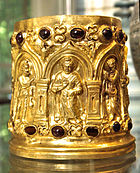Indra
Jump to navigation
Jump to search

Indra (/ˈɪndrə/, Sanskrit: इन्द्र) is a ancient Vedic deity, a deity in Hinduism, a guardian deity in Buddhism, and the king of the highest heaven called Saudharmakalpa in Jainism.
| This religion-related article is a stub. You can help Wikiquote by expanding it. |
Quotes[edit]
- All songs give increase to Indra who is as expansive as the sea.
- Rigveda I.11.1
- Quoted in Frawley, David. The Rig Veda and the History of India. (2001). Quoted from Frawley, D. The Hindu, 25th June 2002. WITZEL’S VANISHING OCEAN – HOW TO READ VEDIC TEXTS ANY WAY YOU LIKE. A Reply to Michael Witzel’s article “A Maritime Rigveda? How not to read the Ancient Texts”.
- Indra has an extent like the sea.
- Rigveda I.30.3
- Quoted in Frawley, David. The Rig Veda and the History of India. (2001). Quoted from Frawley, D. The Hindu, 25th June 2002. WITZEL’S VANISHING OCEAN – HOW TO READ VEDIC TEXTS ANY WAY YOU LIKE. A Reply to Michael Witzel’s article “A Maritime Rigveda? How not to read the Ancient Texts”.
He slew the dragon lying at the foot of the mountain. The creator fashioned for him his flashing thunderbolt. As milch cows bellowing as they flowed, directly the waters entered the ocean.
- Rigveda I.32.2
- Quoted in Frawley, David. The Rig Veda and the History of India. (2001). Quoted from Frawley, D. The Hindu, 25th June 2002. WITZEL’S VANISHING OCEAN – HOW TO READ VEDIC TEXTS ANY WAY YOU LIKE. A Reply to Michael Witzel’s article “A Maritime Rigveda? How not to read the Ancient Texts”.
- Indra was the god of the thunderstorm that puts an end to the oppressive summer heat and opens the rainy season.... However, the Buddha arrived just in time for Indra to play a role in his career. it was Indra himself who persuaded the freshly awakened Shakyamuni to start preaching his newfound path. Buddhist monks then spread the cult of Indra to foreign lands as far as Japan. Indra’s weapon, the lightning or vajra, became the emblem of instant Enlightenment. The sought-after “Self-nature” (Chinese zixing) is present all the time, deep in all of us; but when we embark on the path of meditation and finally awaken to it, it strikes like lightning.
- Elst, Koenraad. Hindu dharma and the culture wars. (2019). New Delhi : Rupa.
- “the legend of Indra’s slaying VRtra… in the Vedas is merely an allegorical narrative of the production of rain. VRtra, sometimes also named Ahi, is nothing more than the accumulation of vapour condensed or figuratively shut up in, or obstructed by, a cloud. Indra, with his thunderbolt, or atmospheric or electrical influence, divides the aggregate mass, and vent is given to the rain which then descends upon the earth.”
- Wilson, quoted by Griffith, R. Hymns of the Rigveda (complete translation) by Ralph T.H. Griffith, 1889. (Edition used in this volume published by Munshiram Manoharlal Publishers Pvt. Ltd., New Delhi, 1987). Quoted in Talageri, S. (2000). The Rigveda: A historical analysis. New Delhi: Aditya Prakashan.
- Indra stands accused (of destroying the Harappan civilization).
- Attributed to Sir Mortimer Wheeler. E.g., "All the same, a whole superstructure of invasionist readings of Indian symbols and mythology has been erected on the invasionist suspicion that, in Sir Mortimer Wheeler’s famous words, “Indra stands accused” of destroying the Harappan civilization." in Elst, Koenraad (1999). Update on the Aryan invasion debate New Delhi: Aditya Prakashan.
- Shiva is by no means a non-Vedic god, and Indra never really disappeared from popular Hinduism but lives on under another name.
- Elst, Koenraad (1999). Update on the Aryan invasion debate New Delhi: Aditya Prakashan.
- Temples were built in ancient times in Tamilnadu for worshipping Indra. Grand festivals were celebrated by the Tamil kings in honor of Indra, the “the national hero of the Aryans.’ Indra was so much cherished by the Tamil people, that priority of worship was given to him in the great Epic Silappadikaram’ – the epic of the Anklet. Besides, references to Indra worship are found in Tholkapiam (600 BCE) Purananuru, Paripadal Aingurunuru and Pattupaddu, all belonging to the Sangam period. Certainly Seran Senguttuvan, his brother Illango Adikal, and, above all, the great Sangam Poets were not naïve as to accept Indra the lord of the Aryans who were the enemies of the Dravidians as their God, How can historians reconcile these contradictory views?
- Attributed. (source: Perennial Hindu Culture and The Twin Myths – By M. Vaitialingam The Thirumaka Press. 1980 p. 22-37). [1]
